Common menu bar links
Breadcrumb Trail
ARCHIVED - Public Health Agency of Canada - Report
 This page has been archived.
This page has been archived.
Archived Content
Information identified as archived on the Web is for reference, research or recordkeeping purposes. It has not been altered or updated after the date of archiving. Web pages that are archived on the Web are not subject to the Government of Canada Web Standards. As per the Communications Policy of the Government of Canada, you can request alternate formats on the "Contact Us" page.
Section III – Supplementary Information
3.1 Financial Highlights
The future-oriented financial highlights presented in this report provide a general overview of the Agency’s financial position and operations. Future-oriented Financial Statements are prepared on an annual basis to strengthen accountability and improve transparency and financial management. The statements are located on the Agency’s Web site at ![]() http://www.phac-aspc.gc.ca/rpp/2011-2012/fofs-erp-eng.php.
http://www.phac-aspc.gc.ca/rpp/2011-2012/fofs-erp-eng.php.
| Future-oriented Condensed Statement of Operations for the year ended March 31 | % change | Future-oriented 2011–12 |
Future-oriented* 2010–11 |
|---|---|---|---|
| Total Expenses | 7.0 | 678.9 | 634.2 |
| Total Revenues | (33.0) | 0.2 | 0.3 |
| Net Cost of Operations | 7.0 | 678.7 | 633.9 |
The Agency is forecasting $678.9M in expenses based on 2011-12 Main Estimates and accrued information. The expenses are broken down as follows: salaries and wages $235.5M; transfer payments $196.5M; professional and special services $96.6M; utilities, material and supplies $71.8M; accommodation $22.2M; travel and re-location $14.8M; amortization $10.7M; other $10.6M; information $8.2M; communication $5.5M; purchase repair and maintenance $5.0M; and rentals $1.7M.
| Future-oriented Condensed Statement of Operations for the year ended March 31 | % change | Future-oriented 2011–12 |
Future-oriented 2010–11 |
|---|---|---|---|
| Total Assets | 6.8 | 208.7 | 195.5 |
| Total Liabilities | (1.5) | 144.0 | 146.2 |
| Equity | 31.0 | 64.7 | 49.4 |
| Total Liabilities and Equity of Canada | 6.8 | 208.7 | 195.5 |
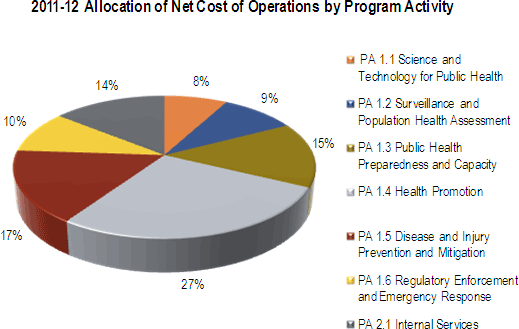
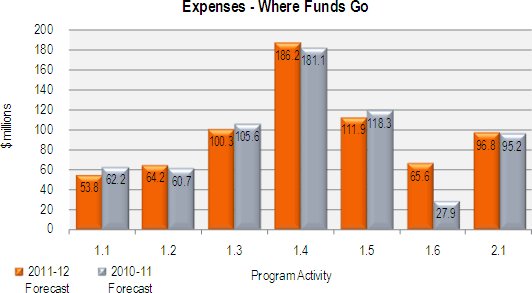
Breaking down the $678.9M of Agency expenses by Program Activity allocates: $53.8M to Science and Technology for Public Health (PA 1.1); $64.2 to Surveillance and Population Health Assessment (PA 1.2); $100.3M to Public Health Preparedness and Capacity (PA 1.3); $186.2M to Health Promotion (PA 1.4); $111.9M to Disease and Injury Prevention (PA 1.5); $65.6M to Regulatory Enforcement and Emergency Response (PA 1.6); and $96.8M to Internal Services (PA 2.1).
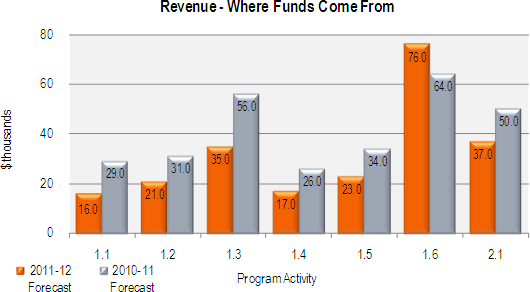
The Public Health Agency of Canada is forecasting $225K in revenues based on 2011-12 Main Estimates and accrued information. The revenues are broken down as follows: Services of a Non-Regulatory Nature $137K; Rights and Privileges $18K, a decrease of $67K related to royalties; other $62K and interest $8K. The 2011-12 forecast figures reflect the trend from previous years which included revenues from the sale of first aid kits and other royalty payments received.
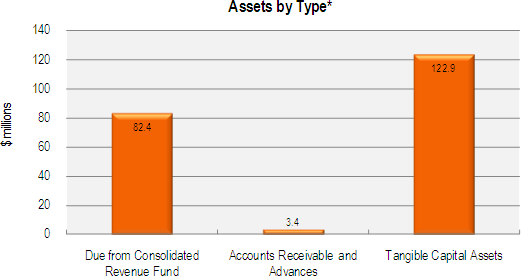
*This is the first year PHAC has reported a statement of financial position; therefore, no comparative 2010-11 figures are available.
Total assets are forecast to be $208.7M for 2011-12, an increase of $13.1M over the 2010-11 forecast. The amount due from the Consolidated Revenue Fund is forecast to be $82.4M. Accounts receivable is forecast to be $3.4M. Capital assets are forecast to be $122.9M, an increase of $12.2M over the 2010-11 forecast.
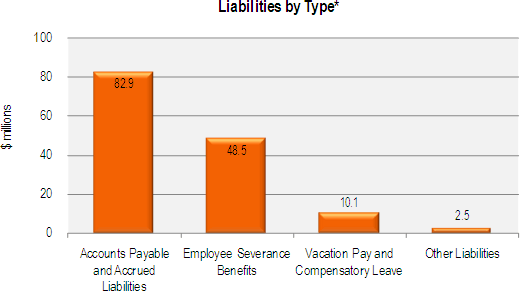
*This is the first year PHAC has reported a statement of financial position, therefore no comparative 2010-11 figures are available.
Total liabilities are forecast to be $144M for 2011-12, a net decrease of $2.2M over the 2010-11 forecast. The breakdown of liabilities is as follows: accounts payable and accrued liabilities $83M; employee severance benefits $48.5M; vacation pay and compensatory leave $10.1M and other liabilities $2.5M.
3.2 List of Supplementary Information Tables
All electronic Supplementary Information tables found in the 2011-12 Report on Plans and Priorities can be found on the Treasury Board of Canada Secretariat’s Web site at ![]() http://www.tbs-sct.gc.ca/rpp/2011-2012/info/info-eng.asp.
http://www.tbs-sct.gc.ca/rpp/2011-2012/info/info-eng.asp.
- Details on Transfer Payment Programs
- Greening Government Operations
- Horizontal Initiatives
- Upcoming Internal Audits and Evaluations over the next three fiscal years
- Sources of Respendable Revenue
- Summary of Capital Spending by Program Activity
The following table is located on the Agency’s Web site:
![]() Summary of Three-year Plan for Transfer Payment Programs
Summary of Three-year Plan for Transfer Payment Programs
Section IV – Other Items of Interest
Sustainable Development at the Agency
Based on the Federal Sustainable Development Strategy, the Public Health Agency of Canada commits to:
- Providing more specific information on departmental sustainable development activities appropriate to the department or agency’s mandate;
- Strengthening the application of Strategic Environmental Assessments (SEAs) by ensuring that the Government’s environmental goals are taken into account when pursuing social and economic goals; and
- Pursuing best practices on reporting on summary information on the results of SEAs linked to the FSDS goals and targets, in order to ensure that environmental decision making is more transparent.
For additional details on the Agency’s activities to support sustainable development please see ![]() http://www.phac-aspc.gc.ca/sd-dd/index-eng.php, and for complete details on the Federal Sustainable Development Strategy please see
http://www.phac-aspc.gc.ca/sd-dd/index-eng.php, and for complete details on the Federal Sustainable Development Strategy please see ![]() http://www.ec.gc.ca/dd-sd/default.asp?lang=En&n=C2844D2D-1.
http://www.ec.gc.ca/dd-sd/default.asp?lang=En&n=C2844D2D-1.
Additional Web Links
abc
[Footnotes]
1 Federal Sustainable Development Strategy (FSDS) Web site: ![]() http://www.ec.gc.ca/dd-sd/default.asp?lang=EN&n=C2844D2D-1.
http://www.ec.gc.ca/dd-sd/default.asp?lang=EN&n=C2844D2D-1.
2 PHAC Web site: ![]() http://www.phac-aspc.gc.ca/sd-dd/index-eng.php.
http://www.phac-aspc.gc.ca/sd-dd/index-eng.php.
3 HALE is an indicator of overall population health that combines measures of both age- and sex-specific health status, and age- and sex-specific mortality into a single statistic. It represents the number of expected years of life equivalent to years lived in full health,
based on the average experience in a population.
* Report on the State of Public Health in Canada 2010
4 Statistics Canada. CANSIM Table 102-0121 and Catalogue no. 82-221-X.
5 Colley, Rachel C. et al. Physical activity of Canadian adults: Accelerometer results from the 2007 to 2009 Canadian Health Measures Survey. Statistics Canada, Catalogue no. 82-003-XPE, Health Reports, Vol. 22, no. 1, March 2011. ![]() http://www.statcan.gc.ca/pub/82-003-x/2011001/article/11396-eng.pdf. [Accessed January 28, 2011].
http://www.statcan.gc.ca/pub/82-003-x/2011001/article/11396-eng.pdf. [Accessed January 28, 2011].
6 Public Health Agency of Canada. 2009. Obesity in Canada – Snapshot. ![]() http://www.phac-aspc.gc.ca/publicat/2009/oc/index-eng.php. [Accessed February 2, 2011].
http://www.phac-aspc.gc.ca/publicat/2009/oc/index-eng.php. [Accessed February 2, 2011].
7 Curbing Childhood Obesity: A federal, Provincial and Territorial Framework for Action to Promote Healthy Weights. (September 2010) ![]() http://www.phac-aspc.gc.ca/hp-ps/hl-mvs/framework-cadre/pdf/ccofw-eng.pdf. [Accessed February 2, 2011].
http://www.phac-aspc.gc.ca/hp-ps/hl-mvs/framework-cadre/pdf/ccofw-eng.pdf. [Accessed February 2, 2011].
8 Statistics Canada. (September 27, 2010)The Daily. Canadian Tobacco Use Monitoring Survey. (previously released)![]() http://www.statcan.gc.ca/daily-quotidien/100927/dq100927c-eng.htm.
[Accessed January 28, 2011].
http://www.statcan.gc.ca/daily-quotidien/100927/dq100927c-eng.htm.
[Accessed January 28, 2011].
9 Statistics Canada. 2007a. 2006 Census: Portrait of the Canadian Population in 2006: National portrait. ![]() http://www12.statcan.ca/census-recensement/2006/as-sa/97-550/p2-eng.cfm [Accessed November 30, 2010].
http://www12.statcan.ca/census-recensement/2006/as-sa/97-550/p2-eng.cfm [Accessed November 30, 2010].
10 Food and Agriculture Organization of the United Nations (FAO). 2008. Climate Change: Implications for food safety. ![]() http://www.fao.org/docrep/010/i0195e/i0195e00.htm [Accessed December 7,
2010].
http://www.fao.org/docrep/010/i0195e/i0195e00.htm [Accessed December 7,
2010].
11 The built environment can be broadly defined as environments that have been created or modified by people such as: neighbourhood designs; schools; homes; workplaces; recreation areas; location of stores; and the location and design of roads; sidewalks, bike lanes and footpaths. It is a key determining factor to promote physical activity and prevent obesity.
12 Canadian Medical Association. No Breathing Room: National Illness Costs of Air Pollution. August 2008. ![]() http://www.cma.ca/multimedia/CMA/Content_Images/Inside_cma/Office_Public_Health/ICAP/CMA_ICAP_sum_e.pdf [Accessed December 6, 2010].
http://www.cma.ca/multimedia/CMA/Content_Images/Inside_cma/Office_Public_Health/ICAP/CMA_ICAP_sum_e.pdf [Accessed December 6, 2010].
13 Statistics Canada (May 10, 2010). The Daily. Canada Internet Usage Survey (previously released). ![]() http://www.statcan.gc.ca/daily-quotidien/100510/dq100510a-eng.htm. [Accessed
December 6, 2010].
http://www.statcan.gc.ca/daily-quotidien/100510/dq100510a-eng.htm. [Accessed
December 6, 2010].
14 Discovery research is carried out to increase knowledge and understanding. This generates new scientific ideas, principles, theories and ways of thinking. Applied research takes these new concepts and translates them into new methods, applications or technologies. For example, discovery research may investigate how the human immune system works or how micro-organisms interact with humans and cause disease, whereas applied research may investigate ways to diagnosis or prevent a specific disease, such as developing a new vaccine.
15 The built environment can be broadly defined as environments that have been created or modified by people such as: neighbourhood designs; schools; homes; workplaces; recreation areas; location of stores; and the location and design of roads; sidewalks, bike lanes and footpaths. It is a key determining factor to promote physical activity and prevent obesity.
16 Sex and Gender Based Analysis is an approach to research, programs and policies which systemically inquires about biological (sex-based) and socio-cultural (gender-based) differences between women and men, boys and girls, without presuming that any differences exist. The purpose of SGBA is to promote rigorous
sex/gender-sensitive health research, policies and programs which expand the understanding of health determinants in both sexes in order to provide knowledge which may result in improvements in health and health care. ![]() http://www.hc-sc.gc.ca/hl-vs/pubs/women-femmes/sgba-policy-politique-ags-eng.php [accessed January 26, 2011]
http://www.hc-sc.gc.ca/hl-vs/pubs/women-femmes/sgba-policy-politique-ags-eng.php [accessed January 26, 2011]
17 Diabetes, cancer, and hypertension are the only chronic diseases for which the Agency will have incidence data for in 2011-12. Work is ongoing to develop baseline data for incidence of additional chronic diseases such as asthma and COPD over the next few years.
18 The Microbiology Emergency Response Team (MERT) is a mobile laboratory capacity that deploys on short notice to assist around the world in public health crises. Staffed by the National Microbiology Laboratory, and working closely with the WHO, the mobile lab capacity includes a range of options from state of the art portable lab equipment to the mobile lab-truck and lab-trailer. MERT can be deployed prior to major international events to identify and process potential pathogens and enhance event security as well as train staff in outbreak response and develop new diagnostic tests that can detect emerging infectious agents rapidly and efficiently.
